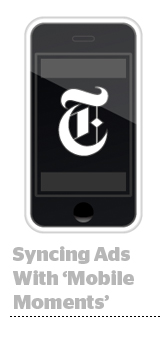 The New York Times hopes to address mobile advertising problems with a customizable native in-stream ad unit called Mobile Moments, set for a mid-September launch.
The New York Times hopes to address mobile advertising problems with a customizable native in-stream ad unit called Mobile Moments, set for a mid-September launch.
The publisher built the unit in-house using insights from its editorial team. It will be available both on apps and the mobile web, and a few advertisers have already signed on. (The Times wouldn’t specify how many.)
The Times hopes these direct sold, premium ad units will help it generate more revenue to a mobile audience that has been undermonetized.
Like most publishers, mobile revenue at the Times lags. In its Q1 earnings report in April, for instance, the Times reported that mobile accounted for 10% of digital ad revenue. At the same time, mobile is about to overtake desktop as a source of traffic, said Sebastian Tomich, SVP of advertising and innovation.
In a desktop environment, article content is an important consideration when delivering a contextual ad. But in mobile, because the screen is too small to show an ad and article content at the same time, Tomich said, the device use case is a more important consideration for advertisers.
Consequently, the creative in the mobile unit will change based on time of day, as audience needs and reading habits shift. The Times, for instance, buckets audience expectations into seven categories. In the morning, they might simply want to prepare for the day. Later, they might want to follow developing news or be entertained.
The Times’ editorial team curates articles on its mobile properties based on those patterns: Morning content focuses on what people need to know for the day, while evening content includes more videos, photos and news analysis. Advertisers using Mobile Moments will be able to leverage these insights as well.
“It’s dayparting with the backbone of editorial insight telling you why those moments are important and how you should be promoting them,” Tomich said.
Mobile Moments developed out of a five-month collaboration between the editorial and ad innovation teams.
“We see this [collaboration] as a framework for future development,” Tomich said. “The best ad products we develop will come from newsroom insights because they are solely focused on driving more engagment and thinking about reader needs.”
Advertisers can supply the content for Mobile Moments themselves, or they can rely on T Brand Studio, the Times’ custom content studio which creates paid posts like the now-famous piece for “Orange Is The New Black”.
To maximize viewability, the entire ad unit will show up in-stream. A “card” will mimic the same headline/lede structure the Times uses in the article preview. The unit, which can include graphics, video or interactivity, will appear below, taking up 75% of the screen.











